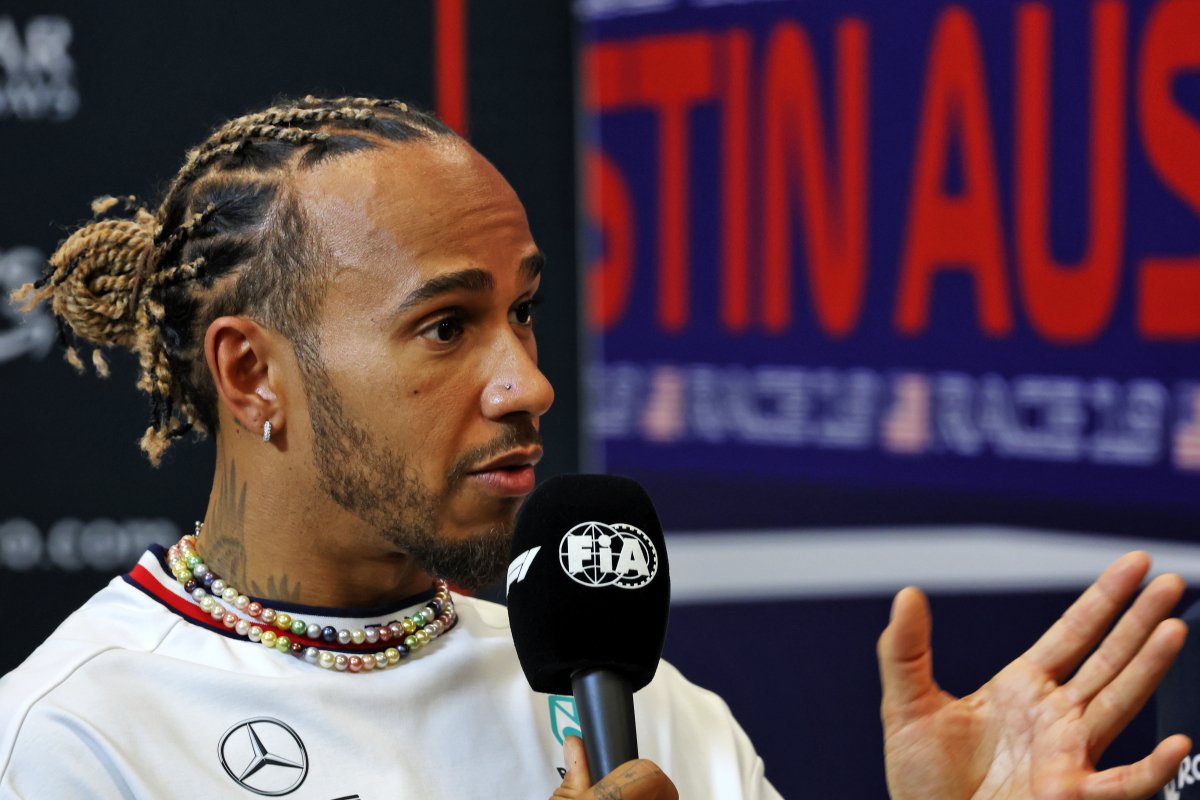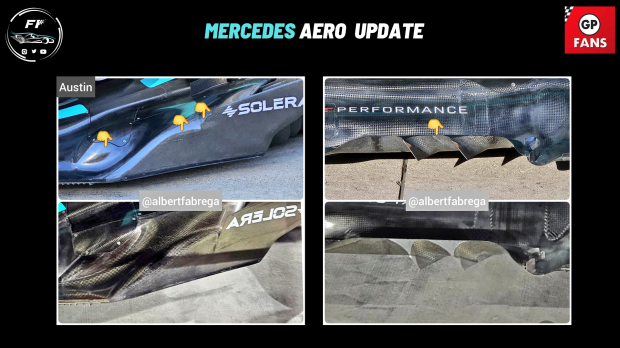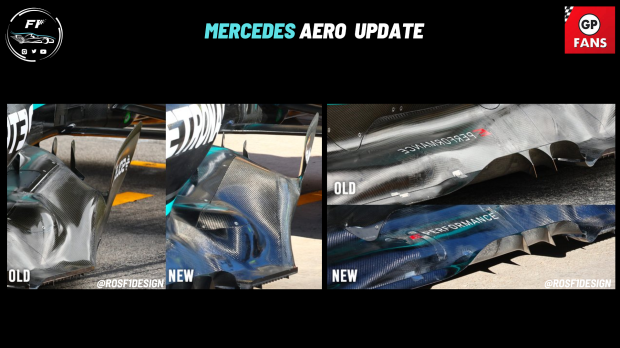
How Mercedes added EXTRA pace to this season's package
How Mercedes added EXTRA pace to this season's package

Lewis Hamilton's performance at the United States Grand Prix was impressive, considering he qualified only 0.139 seconds behind Ferrari driver Charles Leclerc's pole time.
Despite having limited time to adjust to the new Mercedes car floor, Hamilton expressed his satisfaction with the team's progress, describing it as 'one of the first upgrades that I've actually felt over the last two years'.
When asked about where the car has become more competitive, he replied: "The car feels almost the same, it's just levelled up pretty much everywhere."
This suggests that the upgrade has made the car more competitive and balanced, allowing him to perform at a higher level. In this article, let us look at the aero upgrades and what they may be doing.
READ MORE: F1 Qualifying Results - United States Grand Prix 2023 times as Verstappen BLUNDERS

Front Floor Update
The elevation of the leading edge of the floor is likely to bring about changes in the distribution of load along the fences. Consequently, this modification is expected to influence the integrity and efficiency of the vortex structures beneath the floor.
It is especially crucial to consider the load on the innermost fence to enhance forward floor loading and on the outermost fence to improve the flow quality at the rear of the car.

Floor Edge Wing Update
The increased camber on the leading edge of the wing's floor section is expected to enhance the extraction of air from the front floor, leading to a greater forward floor load.
However, it may also lead to an increase in local load through the floor edge wing. This change is likely possible due to alterations in the distribution of loading around the fences.
How did it perform – and what's next?
Throughout the year, Mercedes have grappled with a lack of rear grip due to a downforce deficit in faster corners. The first sector at Austin served as a litmus test for this issue, and while Mercedes displayed reasonable pace, they fell slightly behind Red Bull, Ferrari, and even Alpine, who surprisingly ranked third in the first sector.
Hamilton secured the fastest time in the middle sector and placed fourth in the slower final sector. We can also usually pick up hints from the body language and comments from the drivers and the technical personnel from the company.
Mercedes' technical director James Allison referred to the update as a 'litmus test for our overall direction'. Lewis Hamilton's remarks indicate his confidence in the team's trajectory, not just regarding their 2023 development but more critically for next year's car.
Although Hamilton refrained from making bold predictions for the upcoming season, he remains optimistic that Mercedes can make the necessary improvements to return to a 'highly competitive mode'. This sentiment holds particular weight, given that Hamilton has openly expressed his discontent with Mercedes' progress in the past 18 months.
In the words of trackside engineering director Andrew Shovlin: "The upgraded floor appears to be delivering the anticipated results."
While the performance upgrade hasn't radically transformed the car, its successful implementation affirms that reality aligns with the outcomes predicted by the various simulation tools.
READ MORE: Hamilton makes WINNING declaration after starring in US F1 qualifying
Related news

Marko declares which F1 Grand Prix was Verstappen's 'toughest'

Why USGP was Lewis Hamilton's 'Michael Schumacher' moment

Leclerc once again left 'disappointed' by Ferrari

Norris and McLaren TEASE Hamilton after US Grand Prix
Most read

FIA take action after Verstappen track limits mishap

F1 News Today: FIA make changes as Mercedes receive double penalty and Horner curses bad luck

Red Bull to replace driver at Abu Dhabi Grand Prix

Stroll issues Alonso Aston Martin contract verdict

Horner takes aim at Kravitz with savage jibe at Sky Sports pundit
F1 Standings

Drivers
- Charles Leclerc
- Carlos Sainz
- Lando Norris
- Oscar Piastri
- Pierre Gasly
- Esteban Ocon
- Sergio Pérez
- Max Verstappen
- Alexander Albon
- Logan Sargeant
- Lewis Hamilton
- George Russell
- Nico Hülkenberg
- Kevin Magnussen
- Fernando Alonso
- Lance Stroll
- Valtteri Bottas
- Zhou Guanyu
- Nyck De Vries
- Liam Lawson
- Daniel Ricciardo
- Yuki Tsunoda
Races
-
 Gulf Air Grand Prix of Bahrain 2023
Gulf Air Grand Prix of Bahrain 2023
-
 Saudi Arabian Grand Prix 2023
Saudi Arabian Grand Prix 2023
-
 Grand Prix of Australia 2023
Grand Prix of Australia 2023
-
 Grand Prix of China 2023
Grand Prix of China 2023
-
 Grand Prix of Azerbaijan 2023
Grand Prix of Azerbaijan 2023
-
 Miami Grand Prix 2023
Miami Grand Prix 2023
-
 Qatar Airways Gran Premio Del Made In Italy E Dell'emilia Romagna 2023
Qatar Airways Gran Premio Del Made In Italy E Dell'emilia Romagna 2023
-
 Grand Prix of Monaco 2023
Grand Prix of Monaco 2023
-
 AWS Gran Premio de España 2023
AWS Gran Premio de España 2023
-
 Grand Prix du Canada 2023
Grand Prix du Canada 2023
-
 Grand Prix of Austria 2023
Grand Prix of Austria 2023
-
 Aramco Grand Prix of Great Britain 2023
Aramco Grand Prix of Great Britain 2023
-
 Grand Prix of Hungary 2023
Grand Prix of Hungary 2023
-
 Grand Prix of Belgium 2023
Grand Prix of Belgium 2023
-
 Heineken Dutch Grand Prix 2023
Heineken Dutch Grand Prix 2023
-
 Grand Prix of Italy 2023
Grand Prix of Italy 2023
-
 Grand Prix of Singapore 2023
Grand Prix of Singapore 2023
-
 Grand Prix of Japan 2023
Grand Prix of Japan 2023
-
 Qatar Grand Prix 2023
Qatar Grand Prix 2023
-
 Grand Prix of the United States 2023
Grand Prix of the United States 2023
-
 Gran Premio de la Ciudad de Mexico 2023
Gran Premio de la Ciudad de Mexico 2023
-
 Rolex Grande Prêmio de São Paulo 2023
Rolex Grande Prêmio de São Paulo 2023
-
 Heineken Silver Las Vegas Grand Prix 2023
Heineken Silver Las Vegas Grand Prix 2023
-
 Grand Prix of Abu Dhabi 2023
Grand Prix of Abu Dhabi 2023
About GPFans
GPFans is a multi-platform, multi-language brand dedicated to Formula One coverage. We bring you all the ins and outs of the sport, 24/7, everything from up-to-the-minute news and features to the latest viral stories and clips.We believe that a new generation of exciting, outspoken drivers will make F1 more popular than ever before, and we want to give our users access to as much of their heroes as possible, on and off the track. From Lewis Hamilton to Max Verstappen, Daniel Ricciardo to Sebastian Vettel, we provide in-depth analysis of every every Grand Prix in the season, from Australia to Abu Dhabi.
With Formula One under the new ownership of Liberty Media, how the sport is being covered is evolving, and GPFans will look to be at the heart of this progression into new media, as one of the fastest-growing sites covering the king of motorsports.
Follow us on your favorite social media channel
Corporate & Media
 Innovatieweg 20C
Innovatieweg 20C7007 CD, Doetinchem, Netherlands
+31645516860













 Gulf Air Grand Prix of Bahrain 2023
Gulf Air Grand Prix of Bahrain 2023  Saudi Arabian Grand Prix 2023
Saudi Arabian Grand Prix 2023  Grand Prix of Australia 2023
Grand Prix of Australia 2023  Grand Prix of China 2023
Grand Prix of China 2023  Grand Prix of Azerbaijan 2023
Grand Prix of Azerbaijan 2023  Miami Grand Prix 2023
Miami Grand Prix 2023  Qatar Airways Gran Premio Del Made In Italy E Dell'emilia Romagna 2023
Qatar Airways Gran Premio Del Made In Italy E Dell'emilia Romagna 2023  Grand Prix of Monaco 2023
Grand Prix of Monaco 2023  AWS Gran Premio de España 2023
AWS Gran Premio de España 2023  Grand Prix du Canada 2023
Grand Prix du Canada 2023  Grand Prix of Austria 2023
Grand Prix of Austria 2023  Grand Prix of Hungary 2023
Grand Prix of Hungary 2023  Grand Prix of Belgium 2023
Grand Prix of Belgium 2023  Grand Prix of Singapore 2023
Grand Prix of Singapore 2023  Grand Prix of Japan 2023
Grand Prix of Japan 2023  Qatar Grand Prix 2023
Qatar Grand Prix 2023  Gran Premio de la Ciudad de Mexico 2023
Gran Premio de la Ciudad de Mexico 2023  Rolex Grande Prêmio de São Paulo 2023
Rolex Grande Prêmio de São Paulo 2023  Grand Prix of Abu Dhabi 2023
Grand Prix of Abu Dhabi 2023